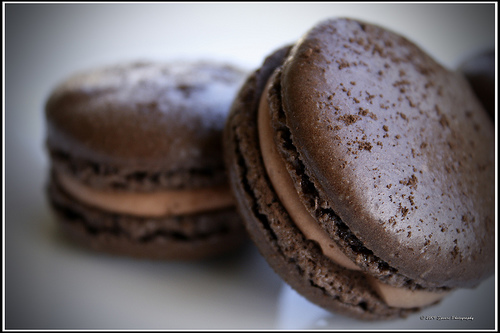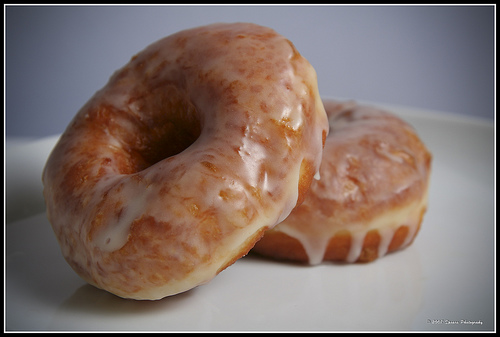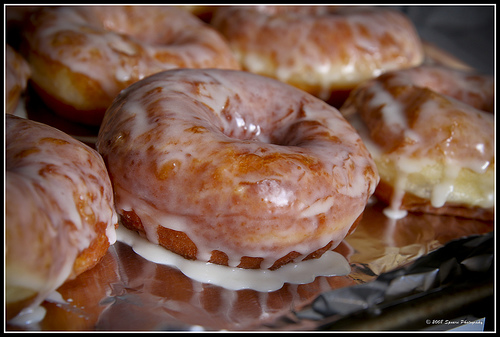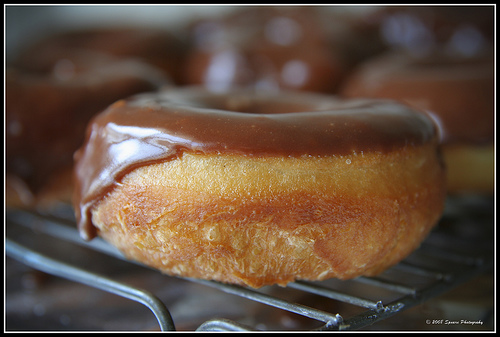-
Posts
2,351 -
Joined
-
Last visited
Content Type
Profiles
Forums
Store
Help Articles
Posts posted by Patrick S
-
-
I feel your pain Leoni. My last two attempts using Italian meringue have ended up looking a bit like yours, and I'm not sure why. I've used Italian meringue methods in the past with success. I have been using an IR thermometer to cook the syrup because my probe thermometer broke, and I'm wondering if that has something to do with it (not sure if it is measuring the syrup temp accurately). Both times the batter has been really stiff and seemed overly dry -- I had to use a wetted finger to tap down the little tips left from piping.
-
Chocolate with chocolate mousseline buttercream, and strawberry with vanilla mousseline buttercream. The strawberry version was made with powdered strawberries. The strawberry version was almost perfect except: they were still slightly too soft, and collapsed a little on the feet, and the powdered strawberry sprinkled on top started to brown a little, detracting from the appearance. Both were made using French meringue methods.


-
Nice macs! Have you tried using spray dried coconut milk? I use it whenever I want coconut flavor in a non-liquid form without the texture of shredded or chopped coconut.
Great idea! I hadn't heard of this product before, but it sounds killer - I love the flavor of coconut but can be put off of the texture of dried coconut depending on how its prepared.
Awesome pics as usual! Are you still using the Italian meringue method? I just bought a 5 kg box of ground almonds today with plans to perfect my macarons.
Thanks CB! I use both the french and italian methods. The coconut and strawberry versions I've made recently were both made using french meringue. I know that most of the pros use the italian meringue method, but in my experience I have had equal success/failure with both.
-
Nice macs! Have you tried using spray dried coconut milk? I use it whenever I want coconut flavor in a non-liquid form without the texture of shredded or chopped coconut.
Great idea! I hadn't heard of this product before, but it sounds killer - I love the flavor of coconut but can be put off of the texture of dried coconut depending on how its prepared.
-
Hi folks! I hope everyone is well -- its been a long time since I've logged in, but I still check the threads from time to time. I've been on a macaron kick lately. One I did was a coconut macaron (using half almond-half coconut), with a passion fruit white chocolate ganache filling. I took great pains to make the coconut very fine - grinding and regrinding it, and them seiving it to remove the bits that refused to be broken down. The filling took some adjustment. I started with a passion fruit curd, but it was too thin to stand up to the cookies. So I made a wc ganache and added some of the curd to that, and it worked fine.

I also made a strawberry macaron with vanilla mousseline buttercream. I actually used fine ground dried strawberries in the cookies, and was pleasantly surprised by the flavor -- nice, strong strawberry flavor and aroma. Will try to post some pics at some point.
-
How about Strawberry Celery cake! A layer of strawberry dacqoise, three layers of strawberry genois, filled with strawberry jam and lemon curd, wrapped in celery mousse, coated in white chocolate glaze. The cage is a bit horrific, but I was just playing with ideas.
Strawberry dacquoise sounds interesting. How do you put the strawberry in the strawberry dacquoise?
-
One of my favorite things to make with it is 'white chocolate dream bars' with lots of orange zest added to the recipe.
Care to share a recipe?
Sure. Here's the recipe. I usually bake it in an 8x8, for maybe 40-45 minutes. I leave out the semisweet chunks, and rub about a tablespoon or so of fine zest into the sugar with my fingers.
-
I like El Rey - but I have had trouble with it melting smoothly, so it depends on what you are going to do with it. Cluizel is nice but taste doesn't justify the price with their white (v. some of the dark). I'm currently using Callebaut and have been happy with taste (although its not my favorite tasting), meltability and price.
I think you make a good point - I would tend to agree that the differences between whites are not as commensurate with price points as with darks.
Definitely agree. I couldn't justify to myself spending ~$33 per kilo on Valrhona Ivoire, for example.
-
Lindt and El Rey are my favorites. I don't like Callebaut or Ghirardhelli's product. Believe it or not, Walmart has a store-brand white chocolate chip which, for the price, are good. One of my favorite things to make with it is 'white chocolate dream bars' with lots of orange zest added to the recipe.
-
Does anyone have a great recipe for doughnuts? I'm looking for something tried and true if possible.
I hear there are good recipes for amish doughnuts. I know the amish doughnuts near us are one of the best.
I've tried looking at amish books on amazon but can't tell is they have any doughnut recipes, I know one has a baked doughnut, but I'm looking for fried.
Thanks,
-z
Alton Brown's recipe is great, IMO.

-
Greetings, egulleteers! I've been away for quite a while, but I check back in from time to time and I'm always impressed and inspired.
Last week I had some unscheduled time off of work and managed to spend a little time in the kitchen. One of things I made was doughnuts, using Alton Brown's recipe. They turned out great. The Homer Simpson in me was very happy.



ETA: Larger versions are available on my Flickr.
-
In addition, the folk wisdom of "avoid anything with scary sounding chemical names" can be misleading. There are plenty of wholesome seeming natural plants that are harmful (most obviously hemlock, and a whole range of mushrooms, less obviously foods like fiddlehead ferns). And there are plenty of scary sounding chemicals that are the stuff of life.
Consider this ingredient list:
Cyclohexane, methylcyclohexane, hydrocarbon, dimethylcyclohexane, ethylcyclohexane, 1,1-diethoxyethane, ethanol, alpha-pinene, 1-methylpropan-1-ol, toluene, alpha-fenchene, camphene, hexanal, an ethyl butenoate, butan-1-ol, beta-pinene, sabinene, xylene, car-3-ene, myrcene, alpha-phellandrene, 3-methylbutan-1-ol, limonene, beta-phellandrene, gama-terpinene, para-cymene, alpha-terpinolene, cis-hex-3-en-1-ol, 2-furfural, ethyl octanoate, alpha-copanene, beta-caryophyllene, ehtyl decanoate, sabinyl acetate, alpha-humulene, ethyl dodecanoate
I know people who would fear contracting cancer just from reading a list like that. But it's actually just a partial list of the naturally ocurring flavor compounds in a mango.
Very good point. There is a strong tendency to assume that materials referred to be their chemical names are harmful, which is not suprising given that the average person's exposure to chemical names is usually in the context of reporting on health risks. While everyone drinks water and life is impossible without it, most people would be pretty wary of deliberately ingesting dihydrogen monoxide. And while most people wouldn't hesitate to add a little vanilla to their sweets, they probably wouldn't be enthusiastic to use 4-hydroxy-3-methoxybenzaldehyde.
-
I'd much rather eat insect parts (most likely grasshopper or cricket for small grains) than the hazardous chemicals in pesticides.
The irony is that while you could probably take extreme measures to eliminate insect parts from food (e.g. growing and processing food indoors under some extremely controlled conditions), a diet including plants could never be free of pesticides, for the simple reason that 99.99% (by weight) of the pesticides in the diet are produced by plants themselves as chemical defenses against predators (Ames, Profett and Gold, 1990). For instance, Ames et al point out that the following 49 natural pesticides occur in cabbage:
Glucosinolates: 2-propenyl glucosinolate (sinigrin),* 3-methylthiopropyl glucosinolate, 3-methylsulfinylpropyl glucosinolate, 3-butenylglucosinolate, 2-hydroxy-3-butenyl glucosinolate, 4-methylthiobutyl glucosinolate, 4-methylsulfinylbutyl glucosinolate,
4-methylsulfonylbutyl glucosinolate, benzyl glucosinolate, 2-phenylethyl glucosinolate, propyl glucosinolate, butyl glucosinolate
Indole glucosinolates and related indoles: 3-indolylmethyl glucosinolate (glucobrassicin), 1-methoxy-3-indolylmethyl glucosinolate
(neoglucobrassicin), indole-3-carbinol,* indole-3-acetonitrile, bis(3-indolyl)methane
Isothiocyanates and goitrin: allyl isothiocyanate,* 3-methylthiopropyl isothiocyanate, 3-methylsulfinylpropyl isothiocyanate, 3-butenyl
isothiocyanate, 5-vinyloxazolidine-2-thione (goitrin), 4-methylthiobutyl isothiocyanate, 4-methylsulfinylbutyl isothiocyanate,
4-methylsulfonylbutyl isothiocyanate, 4-pentenyl isothiocyanate, benzyl isothiocyanate, phenylethyl isothiocyanate
Cyanides: 1-cyano-2,3-epithiopropane, 1-cyano-3,4-epithiobutane, 1-cyano-3,4-epithiopentane, threo-1-cyano-2-hydroxy-3,4-epithiobutane,
erythro-1-cyano-2-hydroxy-3,4-epithiobutane, 2-phenylpropionitrile, allyl cyanide,* 1-cyano-2-hydroxy-3-butene, 1-cyano-3-
methylsulfinylpropane, 1-cyano-4-methylsulfinylbutane
Terpenes: menthol, neomenthol, isomenthol, carvone*
Phenols: 2-methoxyphenol, 3-caffoylquinic acid (chlorogenic acid),* 4-caffoylquinic acid,* 5-caffoylquinic acid (neochlorogenic acid),*
4-(p-coumaroyl)quinic acid, 5-(p-coumaroyl)quinic acid, 5-feruloylquinic acid
Moreover, when natural pesticides are tested for carcinogenicity using the same methods which are used to test the carcinogenicity of synthetic pesticides, a similar proportion of both groups are found to be carcinogenic. There does not appear to be any evidence that the natural pesticides are, as a group, more or less harmful than the synthetic pesticides which are present in vastly smaller quantities. I don't necessarily freak out about that, however, since the methods that are usually used to test for carinogenicity (administering the maximum tolerated dose to an animal every day for life and then looking for tumors after it dies) do not reflect real-world exposures and therefore say very little about what the real-world risks are.
It would seem natural to assume that since natural pesticides have by and large been around for millions of years, that humans would have developed some sort of toxicological immunity to them that they could not have developed against newly developed, sythetic pesticides. Ames, Profet and Gold (1990B) however seem to doubt that:
Humans have not had time to evolve into a "toxic harmony" with all of the plants in their diet. Indeed, very few of the plants that humans eat would have been present in an African hunter-gatherer's diet. The human diet has changed drastically in the last few thousand years, and most humans are eating many recently introduced plants that their ancestors did not-e.g., coffee, cocoa, tea, potatoes, tomatoes, corn, avocados, mangoes, olives, and kiwi fruit. In addition,cruciferous vegetables such as cabbage, broccoli, kale, cauliflower, and mustard were used in ancient times "primarily for medicinal purposes" and were spread as foods across Europe only in the Middle Ages (22, 23). Natural selection works far too slowly for humans to have evolved specific resistance to the food toxins in these newly introduced plants.
My personal practice is to watch the total number of calories I eat and to try not to be too immoderate, too often with alcohol, but otherwise I don't much worry at all about what I eat. Even the bug parts.
Ames, Profet and Gold (1990A). Dietary pesticides (99.99% All Natural). Proceedings of the National Academy of Science 87(19): 7777-7781.
Ames, Profet and Gold (1990A). Nature's chemicals and synthetic chemicals: comparative toxicology. Proceedings of the National Academy of Science 87(19): 7782-7786.
-
I think there's a difference between Nutella and gianduja in the sense that Nutella is a particular brand of gianduja.
Many people really love Nutella. I think that there is a very distinct difference in the taste of Nutella in Italy and the taste of Nutella in the U.S.
Maybe it's high fructose corn syrup, I don't know, I haven't done a side-by-side comparison of the labels. Maybe it's the sugar content. Maybe it's the relationship between the amount of chocolate and the amount of hazelnut. Maybe it's the sourcing of the hazelnuts. Italian hazelnuts are different than American filberts.
You are correct that there are different formulations of Nutella.
is a modified form of gianduja. The exact recipe is a secret closely guarded by Ferrero. According to the product label, the main ingredients of Nutella are sugar and modified vegetable oils, followed far behind by hazelnut, cocoa and skimmed milk, comprising together at most 28% of the ingredients. The recipe for Nutella varies in different countries. In the case of Italy the formulation uses less sugar than the product sold in France. Nutella is marketed as "hazelnut cream" in many countries; it cannot be labeled as a chocolate cream under Italian law, as it does not meet minimum cocoa concentration criteria.Despite being advertised as a healthy breakfast choice for children, about half of the calories in Nutella come from fat (11g in a 37g serving, or 99 kcal out of 200 kcal) and about 40% of the calories come from sugar (20g, 80 kcal). [1]
Listed ingredients
* Australia: sugar, vegetable oil, hazelnuts (13%), skim milk powder (8.7%), fat-reduced cocoa powder (7.4%), emulsifier (soy lecithin), flavouring (vanillin)
* France: sugar, vegetable oil, hazelnuts (13%), fat-reduced cocoa powder (7.4%), skimmed milk powder, emulsifier (soy lecithin), flavouring.
* Germany: sugar, vegetable oil, hazelnuts (13%), fat-reduced cocoa powder, skimmed milk powder (7.5%), emulsifier (soy lecithin), flavouring (vanillin)
* Italy: sugar, vegetable oil, hazelnuts (13%), fat-reduced cocoa powder, skimmed milk powder (5%), whey powder, emulsifier (soy lecithin), flavouring.
* Poland: sugar, rapeseed oil, hazelnuts (13%), cocoa (7.4%), skimmed milk (5%), lactose, soya lecithin, vanillin (an artificial flavor).
* Spain: sugar, vegetable oil, hazelnuts (13%), fat free cocoa (7.4%), skimmed milk powder (6.6%), whey powder, emulsifier (soy lecithin), flavoring.
* United Kingdom : sugar, vegetable oils, hazelnuts (13%), fat-reduced cocoa (7.4%), skimmed milk powder (6.6%), whey powder, emulsifier (soy lecithin, vanillin
* USA & Canada: sugar, modified palm oil, hazelnuts, cocoa, skimmed milk, reduced mineral whey, soy lecithin (an emulsifier), vanillin (an artificial flavor).
None of the varieties appear to contain corn syrup, however.
-
So am I wrong in my thinking? I don't want to shortchange anybody so maybe I'll have to do some blind tasting experiments on some unsuspecting chocolate lovers.
Great idea! Obviously unblinded comparisons are not terribly useful, since it is well-established that products perceived as prestigious or expensive or rare are usually rated higher in such tests. Another idea, which might seem like blasphemy to a chocophile, is that all those subtle, complex flavors in an expensive chocolate -- blackberry or coffee or what-have-you-- are not actually considered desirable qualities by some people. Some people really do prefer a plain-jane, Swiss Miss chocolate flavor.
-
. . .when a soft drink is sweetened with sucrose, over time the acid in the soft drink will actually hydrolyze sucrose into its glucose and fructose components. In fact, according to Marov and Dowling (1990), at typical storage times and temperatures, more than 90% of the sucrose in soft drinks can be hydrolyzed. Therefore, even if a soft drink is sweetened with sucrose, unbound sucrose and fructose will start to appear immediately and be available to participate in carbonyl forming reactions.
Another follow-up.
I was curious what types of sweetener soft drink manufacturers might use instead of HFCS, and it appears that some are, somewhat ironically, using invert sugar. Inverted cane sugar is effectively the exact same thing as HFCS -- equal or nearly equal mixtures of "unbound" fructose and glucose. Though they happen to be created from different precursors, there should be little or no difference in terms of their effect on reactive carbonyl formation, or their physiological effects in people. For instance, Jones Pure Cane Soda Products, which have labels proudly proclaiming that their "good old soda [is] made with pure cane sugar" and contains no high fructose corn syrup, is sweetened with inverted cane sugar.
-
There appears to be another peculiarity with Chi-Tang Ho et al's line of reasoning, at least as it is being presented by the media. The line of reasoning seems to be that since sucrose itself does not contain carbonyls, then soft drinks sweetened with sucrose can not contain carbonyls. The idea is that since glucose and fructose are bound together in sucrose, there is no unbound glucose and fructose available to participate in the forming of carbonyls.
However, this overlooks a simple fact that has been known for many years now -- when a soft drink is sweetened with sucrose, over time the acid in the soft drink will actually hydrolyze sucrose into its glucose and fructose components. In fact, according to Marov and Dowling (1990), at typical storage times and temperatures, more than 90% of the sucrose in soft drinks can be hydrolyzed. Therefore, even if a soft drink is sweetened with sucrose, unbound sucrose and fructose will start to appear immediately and be available to participate in carbonyl forming reactions.
Marov, G.J., Dowling, J.F., 1990. Sugar in beverages. In: Pennington,
N.L., Baker, C.W. (Eds.), Sugar: A User’s Guide to Sucrose, vol. 13.
Van Nostrand Reinhold, New York, pp. 189–211
Just to add a note in proof of the above:
"The sugar inversion process takes place under acidic conditions and speeds up with a decrease in pH. Soft drinks are flavored with acids to achieve the sourness notes essential for their taste profiles. They are therefore acidic drinks, usually in the pH+3 range. This is especially true of the sour fruit flavors, such as lemon and other citrus fruit species. Cola beverages that often use phosphoric acid as the acidulant are at even lower pH values. In carbonated soft drinks, the dissolved carbon dioxide is converted to carbonic acid, which further adds to the acidification of these drinks. Regardless of the exact acid content of such beverages, they can all be considered, to a lesser or greater degree, as acidic solutions. As such, some inversion of the sucrose in these beverages will take place."The Soft Drinks Companion: A Technical Handbook for the Beverage Industry, Maurice Shachman, pp. 81-82.
As pointed out above, the degree of inversion can be greater than 90% by the time the drink is consumed. In the ScienceDaily article discussing this research, it was stated:
In the current study, Chi-Tang Ho, Ph.D., conducted chemical tests among 11 different carbonated soft drinks containing HFCS. He found 'astonishingly high' levels of reactive carbonyls in those beverages. These undesirable and highly-reactive compounds associated with "unbound" fructose and glucose molecules are believed to cause tissue damage, says Ho, a professor of food science at Rutgers University in New Brunswick, N.J. By contrast, reactive carbonyls are not present in table sugar, whose fructose and glucose components are "bound" and chemically stable, the researcher notes.Depending upon how you interpret that last sentence, it is either simply false or astonishingly misleading. Table sugar sitting in a bag in the cabinet is indeed quite stable. Leave it alone for years and it'll still be sucrose. But wait a minute! Aren't we're talking about carbonated soft drinks, which are all acidic solutions, precisely the type of conditions in which sucrose is "unbounded" into glucose and fructose? Furthermore, it is kind of silly to point out that reactive carbonyls are not present in sucrose. The relevant question is whether reactive carbonyls form in the drink itself as sucrose is hydrolyzed and unbound fructose and glucose become available to participate in reactive carbonyl forming reactions.
-
Therefore, even if a soft drink is sweetened with sucrose, unbound sucrose and fructose will start to appear immediately and be available to participate in carbonyl forming reactions.
Does this occur in the syrup used in soda machines as well?
On second thought that whole "immediate" thing kinda answers that.
That would depend on the pH of the syrup. There several types of acidulants used in soft drinks. Some of them (like phosphoric and citric acids) I imagine would be present in the syrup along with the sucrose, so yes, I assume that at least some sucrose hydrolysis would occur. However, since carbonic acid presumably would not form in the drink until the carbonated water is added, I would assume that a drink created "on the spot" by combining syrup and carbonated water would have less of its sucrose hydrolyzed.
-
There appears to be another peculiarity with Chi-Tang Ho et al's line of reasoning, at least as it is being presented by the media. The line of reasoning seems to be that since sucrose itself does not contain carbonyls, then soft drinks sweetened with sucrose can not contain carbonyls. The idea is that since glucose and fructose are bound together in sucrose, there is no unbound glucose and fructose available to participate in the forming of carbonyls.
However, this overlooks a simple fact that has been known for many years now -- when a soft drink is sweetened with sucrose, over time the acid in the soft drink will actually hydrolyze sucrose into its glucose and fructose components. In fact, according to Marov and Dowling (1990), at typical storage times and temperatures, more than 90% of the sucrose in soft drinks can be hydrolyzed. Therefore, even if a soft drink is sweetened with sucrose, unbound sucrose and fructose will start to appear immediately and be available to participate in carbonyl forming reactions.
Marov, G.J., Dowling, J.F., 1990. Sugar in beverages. In: Pennington,
N.L., Baker, C.W. (Eds.), Sugar: A User’s Guide to Sucrose, vol. 13.
Van Nostrand Reinhold, New York, pp. 189–211
-
A recent study at Rutgers has found that adding HFCS to carbonated drinks "makes them up to 10 times richer in harmful carbonyl compounds - elevated in people with diabetes and blamed for causing diabetic complications such as foot ulcers and eye and nerve damage" than similar drinks made with cane sugar.
http://www.newscientist.com/channel/health...up-in-soda.html
Though you have quoted the New Scientist article correctly, I am not sure that New Scientist has summarized the research in question correctly. I hope someone can clarify this. The abstract states that Chi-Tang Ho et al compared HFCS-sweetened drinks to a diet soft drink control, NOT to a sucrose sweetened control.
High fructose corn syrup (HFCS) has been added in various foods and beverages in these three decades. Many epidemic studies have discussed about the large consumption of sugars, such as fructose, sucrose and sweeteners. In our study, reactive carbonyl species (RCS) such as glyoxal (GO), methylglyoxal (MGO) and 3-deoxyglucosone (3-DOG) were detected by their corresponding quinoxaline derivatives using HPLC-UV method in HFCS carbonated soft drinks. From the comparison of HFCS and non-HFCS (diet) carbonated soft drink, it is an apparent conclusion that HFCS is the major source of RCS found in beverages. 5-(Hydroxymethyl)-2-furfural (5-HMF) is detected in HFCS by GC-FID method. The presence of 3-DOG and acid condition is a favorable condition for the production of 5-HMF. The variations of RCS and 5-HMF in the HFCS beverage with addition of epigallocatechin gallate (EGCG) during storage have been further explored.So, two things I would like to see:
1. First and most obviously, I would like to see analytic data showing the difference in reactive carbonyl content between HFCS- and sucrose-sweetened soft drinks where as many other variables as possible are controlled. As stated above, the current study seems only to compare the reactive carbonyl content of HFCS- to that of a diet soft drink, not to sucrose-sweetened soft drinks.
2. Second, and more definitively, I would like to see a simple metabolic study examining the effect of HFCS soda versus sucrose soda on reactive carbonyl levels in vivo, in the body. If HFCS-sweetened drinks increased the levels of reactive carbonyls in the body while sucrose-sweetened drinks did not, that would be much stronger evidence.
-
First, if smoking it--or the idea of smoking it--bothers you, remember that something like 95% of the carcinogenic compounds in the smoke are water-soluble. Just run the smoke through a water bath (hookah, nargilh, or your favorite bong) and you're golden.
Though widely believed, this is in fact completely untrue. Scientific studies of water filtration show that it has either no effect or a counterproductive effect on the ratio of cannabinoid to total tar in cannabis smoke. See, for instance, Gieringer 1996. The only devices that has been shown to reduce the amount of carcinogens in cannabis smoke are vaporizers, the best of which produce a vapor that is +90% cannabinoids and essentially devoid of carcinogens (see Gieringer 2001 and 2004).
Gieringer, 1996. Marijuana Water Pipe and Vaporizer Study. Newsletter of the Multidisciplinary Association for Psychedelic Studies 6(3).
"Contrary to popular impression, waterpipes don't necessarily protect smokers from harmful tars in marijuana smoke, according to a new study sponsored by MAPS and California NORML (National Organization for the Reform of Marijuana Laws). The reason is that waterpipes filter out more psychoactive THC than they do other tars, thereby requiring users to smoke more to reach their desired effect. The study does not rule out the possibility that waterpipes could have other benefits, such as filtering out gases, but it suggests that other methods, such as the use of high potency marijuana, vaporizers, or oral ingestion are needed to avoid harmful toxins in marijuana smoke."
Gieringer, 2001. Cannabis Vaporization: A Promising Strategy for Smoke Harm Reduction. Journal of Cannabis Therapeutics 1(3-4), 153-70.
"The primary health hazard of medical cannabis is respiratory damage from marijuana smoke. Aside from oral ingestion and other non-smoked delivery systems not yet commercially available, strategies for reducing the harm of smoking include: (1) use of higher potency cannabis and (2) smoking devices aimed at eliminating toxins from the smoke. Studies have found that waterpipes and solid filters are ineffectual at improving the THC/tar ratio in cannabis smoke. The most promising alternative appears to be "vaporization," in which cannabis is heated to a point where cannabinoids are emitted without combustion. A feasibility study by NORML and MAPS has demonstrated that an electric vaporizer can successfully generate THC at 185°C while completely suppressing benzene, toluene, and naphthalene formation. Further studies are needed to evaluate how effectively vaporizers suppress other toxins, and how their performance varies using different samples, temperatures, and device designs."
Gieringer et al, 2004. Cannabis Vaporizer Combines Efficient Delivery of THC with Effective Suppression of Pyrolytic Compounds. In: Journal of Cannabis Therapeutics. Russo, ed. 4, 7-27.
-
Hi. Is there anyone who can refer me to research or studies done on the chocolate-health connection? I am interested in research conducted by universities/scientists independent to Mars or Nestle, for example.
Thanks!
You can find some decent review articles online. For instance:
-
Is there really anyone who likes the flavorlessness and greasy mouthfeel of vegetable shortening (partially or fully hydrogenated)??
Probably not, but there certainly are people who prefer the texture of baked goods (e.g. pie crusts) made with a combination of butter and shortening.
-
RLB's lemon chiffon is still my favorite lemon cake. I double the zest and juice. If you try it as a cupcake, report back how it turns out.



Your Daily Sweets (2005-2012)
in Pastry & Baking
Posted · Edited by Patrick S (log)
If I had to pick one that I really liked, its the French meringue recipe in Chocolate Desserts by Pierre Herme. In terms of appearance, they are not the greatest -- they tend to develop irregularities on the surface -- but, they taste great, have a great texture IMHO (never that chalky, sugar crust overload), a great chocolate flavor, and in my experience are totally reliable. I make them just like the recipe says, except that I use aged whites and let them dry for ~30 mins before baking. This is how they turn out for me:
I have also had a good experience with the Italian meringue recipe Nicole Kaplan posted on the demo thread, scaled down to a home kitchen scale.